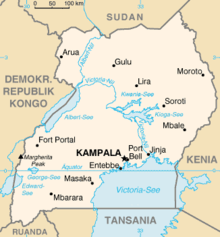Sebei people
 Map of Uganda, where most Sebei live | |
| Total population | |
|---|---|
|
250,000 (Uganda) 25,000 (Sudan) | |
| Regions with significant populations | |
| Sudan | |
| Languages | |
| Sebei languages | |
| Religion | |
| Islam |
The Sebei are an ethnic group of Uganda and Sudan. They speak Sebei and Kupsabiny, both Nilotic languages. Many members of this ethnic group live in the Kapchorwa District of Uganda.
Culture
The Sebei people lead fairly simple lives. The main structures of their lives are centered around cattle keeping, growing crops, and making beer. Common jobs held by the Sebei include cattle keepers and crop farmers. The jobs depend on where you live. Because of their fairly laid back culture, the need for major social structure is limited. There are not many criminal offenses that one could do. In Sebei culture, there are two levels of criminal offense. The highest level is for murder and physical assault, the lower level is for property or major civil disputes between people or groups of people.[1]
Locations
The Sebei live primarily on the slopes of Mount Elgon in eastern Uganda.[2] They number about 275,000 people and occupy the districts of Bukwa, Kapchorwa and Kween. Their territory borders the Republic of Kenya which is a home to more than five million Kalenjin, a large ethnic group to which the Sebei belongs. The Sebei, now known mainly as Sabiny, speak Kupsabiny, a Kalenjin dialect spoken by other smaller groups of Kalenjin stock around Mount Elgon. The Sebei and Kenyan smaller groups (Book, Kony, Mosoop, Someek, Bongomek) inhabiting the hills of Mount Elgon collectively are referred to as the 'Sabaots.
In Uganda
The majority of the Sebei people live in the country of Uganda. The percent of the Ugandan population that is Sebei is only .06%; meaning that there are about 250,000 Sebei in Uganda.
In Sudan
The Sebei of Sudan are an unreached people group. There is not much that there there is to learn about them, as they have not been largely contacted. Although they may seem to be much different from those living in Uganda, they lead very similar lives[3]
See also
References
- ↑ "Demographics". www.daviddfriedman.com. Retrieved 2016-10-25.
- ↑ Goldschmidt, Walter; Gale Goldschmidt (1976). Culture and Behavior of the Sebei: A Study in Continuity and Adaptation. Berkeley, California: University of California Press. p. 11. Retrieved 11 September 2010.
- ↑ PeopleGroups.org. "PeopleGroups.org - Sebei of Sudan". Retrieved 2016-10-25.
